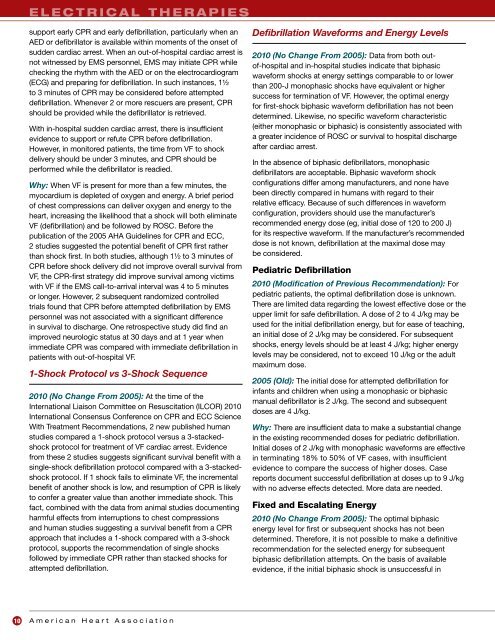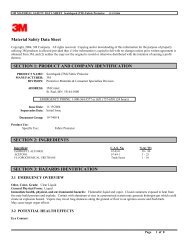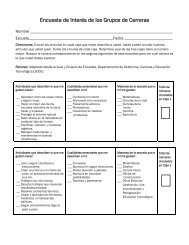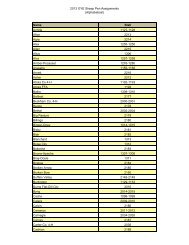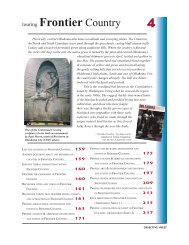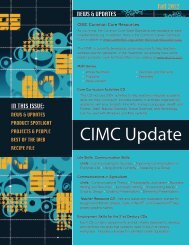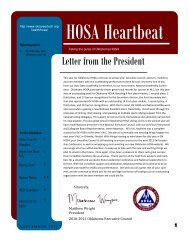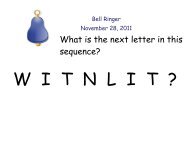Highlights of the 2010 Guidelines for CPR and ECC - ECC Guidelines
Highlights of the 2010 Guidelines for CPR and ECC - ECC Guidelines
Highlights of the 2010 Guidelines for CPR and ECC - ECC Guidelines
You also want an ePaper? Increase the reach of your titles
YUMPU automatically turns print PDFs into web optimized ePapers that Google loves.
e l e c t r i c a l t h e r a p i e s<br />
support early <strong>CPR</strong> <strong>and</strong> early defibrillation, particularly when an<br />
AED or defibrillator is available within moments <strong>of</strong> <strong>the</strong> onset <strong>of</strong><br />
sudden cardiac arrest. When an out-<strong>of</strong>-hospital cardiac arrest is<br />
not witnessed by EMS personnel, EMS may initiate <strong>CPR</strong> while<br />
checking <strong>the</strong> rhythm with <strong>the</strong> AED or on <strong>the</strong> electrocardiogram<br />
(ECG) <strong>and</strong> preparing <strong>for</strong> defibrillation. In such instances, 1½<br />
to 3 minutes <strong>of</strong> <strong>CPR</strong> may be considered be<strong>for</strong>e attempted<br />
defibrillation. Whenever 2 or more rescuers are present, <strong>CPR</strong><br />
should be provided while <strong>the</strong> defibrillator is retrieved.<br />
With in-hospital sudden cardiac arrest, <strong>the</strong>re is insufficient<br />
evidence to support or refute <strong>CPR</strong> be<strong>for</strong>e defibrillation.<br />
However, in monitored patients, <strong>the</strong> time from VF to shock<br />
delivery should be under 3 minutes, <strong>and</strong> <strong>CPR</strong> should be<br />
per<strong>for</strong>med while <strong>the</strong> defibrillator is readied.<br />
Why: When VF is present <strong>for</strong> more than a few minutes, <strong>the</strong><br />
myocardium is depleted <strong>of</strong> oxygen <strong>and</strong> energy. A brief period<br />
<strong>of</strong> chest compressions can deliver oxygen <strong>and</strong> energy to <strong>the</strong><br />
heart, increasing <strong>the</strong> likelihood that a shock will both eliminate<br />
VF (defibrillation) <strong>and</strong> be followed by ROSC. Be<strong>for</strong>e <strong>the</strong><br />
publication <strong>of</strong> <strong>the</strong> 2005 AHA <strong>Guidelines</strong> <strong>for</strong> <strong>CPR</strong> <strong>and</strong> <strong>ECC</strong>,<br />
2 studies suggested <strong>the</strong> potential benefit <strong>of</strong> <strong>CPR</strong> first ra<strong>the</strong>r<br />
than shock first. In both studies, although 1½ to 3 minutes <strong>of</strong><br />
<strong>CPR</strong> be<strong>for</strong>e shock delivery did not improve overall survival from<br />
VF, <strong>the</strong> <strong>CPR</strong>-first strategy did improve survival among victims<br />
with VF if <strong>the</strong> EMS call-to-arrival interval was 4 to 5 minutes<br />
or longer. However, 2 subsequent r<strong>and</strong>omized controlled<br />
trials found that <strong>CPR</strong> be<strong>for</strong>e attempted defibrillation by EMS<br />
personnel was not associated with a significant difference<br />
in survival to discharge. One retrospective study did find an<br />
improved neurologic status at 30 days <strong>and</strong> at 1 year when<br />
immediate <strong>CPR</strong> was compared with immediate defibrillation in<br />
patients with out-<strong>of</strong>-hospital VF.<br />
1-Shock Protocol vs 3-Shock Sequence<br />
<strong>2010</strong> (No Change From 2005): At <strong>the</strong> time <strong>of</strong> <strong>the</strong><br />
International Liaison Committee on Resuscitation (ILCOR) <strong>2010</strong><br />
International Consensus Conference on <strong>CPR</strong> <strong>and</strong> <strong>ECC</strong> Science<br />
With Treatment Recommendations, 2 new published human<br />
studies compared a 1-shock protocol versus a 3-stackedshock<br />
protocol <strong>for</strong> treatment <strong>of</strong> VF cardiac arrest. Evidence<br />
from <strong>the</strong>se 2 studies suggests significant survival benefit with a<br />
single-shock defibrillation protocol compared with a 3-stackedshock<br />
protocol. If 1 shock fails to eliminate VF, <strong>the</strong> incremental<br />
benefit <strong>of</strong> ano<strong>the</strong>r shock is low, <strong>and</strong> resumption <strong>of</strong> <strong>CPR</strong> is likely<br />
to confer a greater value than ano<strong>the</strong>r immediate shock. This<br />
fact, combined with <strong>the</strong> data from animal studies documenting<br />
harmful effects from interruptions to chest compressions<br />
<strong>and</strong> human studies suggesting a survival benefit from a <strong>CPR</strong><br />
approach that includes a 1-shock compared with a 3-shock<br />
protocol, supports <strong>the</strong> recommendation <strong>of</strong> single shocks<br />
followed by immediate <strong>CPR</strong> ra<strong>the</strong>r than stacked shocks <strong>for</strong><br />
attempted defibrillation.<br />
Defibrillation Wave<strong>for</strong>ms <strong>and</strong> Energy Levels<br />
<strong>2010</strong> (No Change From 2005): Data from both out<strong>of</strong>-hospital<br />
<strong>and</strong> in-hospital studies indicate that biphasic<br />
wave<strong>for</strong>m shocks at energy settings comparable to or lower<br />
than 200-J monophasic shocks have equivalent or higher<br />
success <strong>for</strong> termination <strong>of</strong> VF. However, <strong>the</strong> optimal energy<br />
<strong>for</strong> first-shock biphasic wave<strong>for</strong>m defibrillation has not been<br />
determined. Likewise, no specific wave<strong>for</strong>m characteristic<br />
(ei<strong>the</strong>r monophasic or biphasic) is consistently associated with<br />
a greater incidence <strong>of</strong> ROSC or survival to hospital discharge<br />
after cardiac arrest.<br />
In <strong>the</strong> absence <strong>of</strong> biphasic defibrillators, monophasic<br />
defibrillators are acceptable. Biphasic wave<strong>for</strong>m shock<br />
configurations differ among manufacturers, <strong>and</strong> none have<br />
been directly compared in humans with regard to <strong>the</strong>ir<br />
relative efficacy. Because <strong>of</strong> such differences in wave<strong>for</strong>m<br />
configuration, providers should use <strong>the</strong> manufacturer’s<br />
recommended energy dose (eg, initial dose <strong>of</strong> 120 to 200 J)<br />
<strong>for</strong> its respective wave<strong>for</strong>m. If <strong>the</strong> manufacturer’s recommended<br />
dose is not known, defibrillation at <strong>the</strong> maximal dose may<br />
be considered.<br />
Pediatric Defibrillation<br />
<strong>2010</strong> (Modification <strong>of</strong> Previous Recommendation): For<br />
pediatric patients, <strong>the</strong> optimal defibrillation dose is unknown.<br />
There are limited data regarding <strong>the</strong> lowest effective dose or <strong>the</strong><br />
upper limit <strong>for</strong> safe defibrillation. A dose <strong>of</strong> 2 to 4 J/kg may be<br />
used <strong>for</strong> <strong>the</strong> initial defibrillation energy, but <strong>for</strong> ease <strong>of</strong> teaching,<br />
an initial dose <strong>of</strong> 2 J/kg may be considered. For subsequent<br />
shocks, energy levels should be at least 4 J/kg; higher energy<br />
levels may be considered, not to exceed 10 J/kg or <strong>the</strong> adult<br />
maximum dose.<br />
2005 (Old): The initial dose <strong>for</strong> attempted defibrillation <strong>for</strong><br />
infants <strong>and</strong> children when using a monophasic or biphasic<br />
manual defibrillator is 2 J/kg. The second <strong>and</strong> subsequent<br />
doses are 4 J/kg.<br />
Why: There are insufficient data to make a substantial change<br />
in <strong>the</strong> existing recommended doses <strong>for</strong> pediatric defibrillation.<br />
Initial doses <strong>of</strong> 2 J/kg with monophasic wave<strong>for</strong>ms are effective<br />
in terminating 18% to 50% <strong>of</strong> VF cases, with insufficient<br />
evidence to compare <strong>the</strong> success <strong>of</strong> higher doses. Case<br />
reports document successful defibrillation at doses up to 9 J/kg<br />
with no adverse effects detected. More data are needed.<br />
Fixed <strong>and</strong> Escalating Energy<br />
<strong>2010</strong> (No Change From 2005): The optimal biphasic<br />
energy level <strong>for</strong> first or subsequent shocks has not been<br />
determined. There<strong>for</strong>e, it is not possible to make a definitive<br />
recommendation <strong>for</strong> <strong>the</strong> selected energy <strong>for</strong> subsequent<br />
biphasic defibrillation attempts. On <strong>the</strong> basis <strong>of</strong> available<br />
evidence, if <strong>the</strong> initial biphasic shock is unsuccessful in<br />
10<br />
A m e r i c a n H e a r t A s s o c i a t i o n


